At this year’s CES, a newly focused Sony chose not to display any prototypes for newer and more daring display technologies like OLED, or the company’s own proprietary (and, let’s face it, likely D.O.A.) Crystal LED. Disappointing as that may be, we at least appreciated their honesty, since we’re frankly tired of being teased by manufacturers (LG excepted) with impressive OLED prototypes that never translate into actual products that anyone can actually buy.
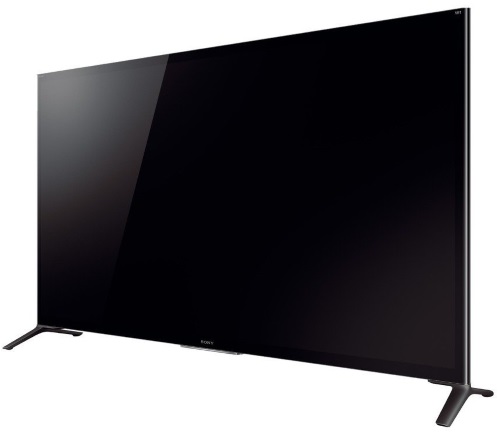
No, in terms of technological elusiveness, the Sony XBR65X950B is as daring as it gets this year. Priced at $8,000 US, this is an ultra high-definition (UHD) 2160p LCD TV with full-array local dimming (FALD) LED backlight. Even moreso now that plasma TVs are finished, it’s this full-array backlighting that generates videophile interest, since it’s the employment of this technology that is LCD’s best hope for coming close to the dark-room picture quality of a plasma display panel (or an OLED screen, for that matter).
Sony’s Triluminos, which is the company’s name for wide color gamut (WCG) technology (apparently this year running from an in-house Sony solution rather than licensed quantum dot technology) is on board, as is HEVC (h.265) codec support should you wish to attempt to view Ultra HD content via the web (sadly, there are precious few alternatives right now, although we hope that situation will change soon). Sony also promises high quality scaling of 1080p and lower resolutions via its Reality Creation processing suite, which we’ll dissect later on.
Thanks to our friends at Value Electronics, we were able to do in-depth assessment of a retail 65-inch Sony X950B in a showroom setting. So, let’s see if this all adds up into a high-res, high-contrast experience!
Jump To: Operation • Calibration • Picture Performance • Conclusion
In the past, we criticized Sony’s TV GUI, which featured various clashing design styles and multi-layered menus. Things are improved a little for 2014, although it’s still some way away from exemplary design. The main home screen is an online content hub, which has paths to the setup controls tucked away as icons at the top right of the display.
We still feel that all picture controls should be located in one place, and there is a puzzling number of layers to these. For example, before making any adjustments, we had to select the “Cinema” [Scene Mode] from a semi-hidden menu, then in the main picture menu, make another mode adjustment (from “Cinema 2” to “Cinema 1“). With that said, too many controls is better than too few, and users who are calibrating only need to set them once and then leave them more or less untouched.
Note: Our Sony XBR-65X950B unit was calibrated using Calman 5.3, the industry-leading video calibration software.
We selected the [Cinema] “Scene” mode from the TV menus and then changed the secondary picture mode to [Cinema 1]. The default mode is [Cinema 2], which distorts colors a little. We disabled features such as [Live Color] (which further deviates from the Rec.709 standard) and [Clear White] (which distorts the color of bright white areas towards blue).
Since this is a full-array backlit LCD TV, we enabled the [Dynamic LED] setting, initially on its “Standard” rather than “Low” mode. This enables the local dimming behavior which accounts for a good amount of the TV’s price, as a result we’d be surprised if anyone shut it off.
We also disabled [Automatic Contrast Enhancer] which adjusts black and white levels on a scene-by-scene basis.
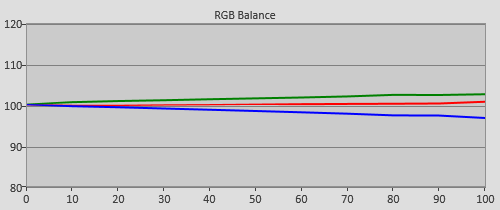 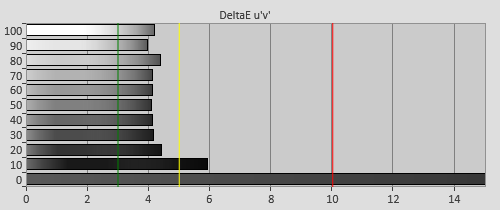 |
| Pre-calibration RGB tracking and delta errors (dEs) |
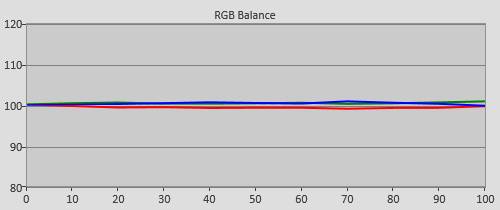 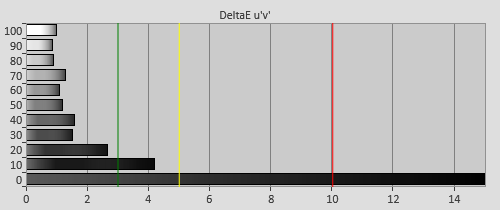 |
| Post-calibration RGB tracking and dEs in [Cinema 1] mode |
![Pre-calibrated Gamma tracking in [Cinema 1] mode](https://www.hdtvtest.co.uk/news/wp-content/uploads/2018/04/uhdtv_US_Sony-XBR65X950B_pre-gamma.png) | ![Post-calibrated Gamma tracking in [Cinema 1] mode](https://www.hdtvtest.co.uk/news/wp-content/uploads/2018/04/uhdtv_US_Sony-XBR65X950B_post-gamma.png) |
| Pre-calibration gamma tracking (2.2) | Post-calibration gamma tracking (2.4) |
![Pre-calibration Color saturation tracking in [Cinema 1] mode](https://www.hdtvtest.co.uk/news/wp-content/uploads/2018/04/uhdtv_US_Sony-XBR65X950B_pre-strack.jpg) |
| Pre-calibration Color saturation tracking |
![Pre-calibration Color errors in [Cinema 1] mode](https://www.hdtvtest.co.uk/news/wp-content/uploads/2018/04/uhdtv_US_Sony-XBR65X950B_pre-strack-de.png) |
| Pre-calibration Color errors (<3 not appreciable to the eye) |
![Post-calibration Color saturation tracking in [Cinema 1] mode](https://www.hdtvtest.co.uk/news/wp-content/uploads/2018/04/uhdtv_US_Sony-XBR65X950B_post-strack.jpg) |
| Post-calibration Color saturation tracking |
![Post-calibration Color errors in [Cinema 1] mode](https://www.hdtvtest.co.uk/news/wp-content/uploads/2018/04/uhdtv_US_Sony-XBR65X950B_post-strack-de.png) |
| Post-calibration Color errors (<3 not appreciable to the eye) |
We should point out that, like every other manufacturer’s UHD displays, the Sony XBR-65X950B only conforms to a very small part of the Rec.2020 UHD specification (the 3840×2160 resolution). Rec.2020 calls for 10-bit or 12-bit coding, and an incredibly wide color gamut. Conversely, all existing “4K TV” displays are using the old CRT-centric HDTV Rec.709 color gamut, and are effectively Rec.709 TVs with Ultra HD resolution but little else.
Sony’s inclusion of their wide color gamut “Triluminous” technology means that, in conjunction with specially mastered Blu-ray Discs and Sony BD players, the Sony XBR-65X950 should be able to deliver a color gamut wider than Rec.709, but not as wide as Rec.2020 (these discs are reportedly using the xvYCC gamut, which is different).
Like all of their consumer displays, the Sony X950B only features basic calibration controls. This should be sufficient for high picture quality providing Sony has done the rest for us correctly.
Relative to the standard HDTV Rec.709 gamut, the 65X950B presents very good color accuracy, which is just as well, since all we have to adjust this are two basic [Color] and [Tint] controls which affect the entire range of colors. This mitigates, but does not eliminate the need for advanced controls.
For example, the fully 100% saturated red color is skewed, and red’s luminance level is too high. We were able to address the latter point by reducing the [Color] control, but had to balance our adjustment since this control affects all colors, not just the one we wanted to address. The end result (shown in charts) is that red remains a little too high whereas the other colors are just a little too low, the best overall compromise. With full calibration controls, there would be no compromise at all, although as it is, the error is too low to be of concern.
Gamma tracking is very good. We verified that there were no brightness spikes or dips across the dynamic range by measuring using a variety of methods (full screen patterns vs windowed patterns) and were pleased to see that there was no significant difference to the display gamma in either case. This strongly suggests that the Sony XBR-65X950B has accurate display of brightness levels without any unwanted in-TV adjustments, and is what we would expect given that the adjustment of the LED brightness levels should be purely spatial (dimming specific areas of the screen) rather than temporal (changing the brightness levels of the entire screen at different times, as would be the case with an automatic contrast system).
However, the lack of any advanced white balance/ grayscale adjustment controls does inhibit performance slightly, even although the overall performance is still good. Sony does include 2-point controls which allows RGB mixing to be adjusted in the dark and bright areas respectively. The controls for the dark areas are so coarse that they are almost unusable, however. This means that we couldn’t avoid near-black areas remaining tinted, although we could at least mitigate it by adjusting the controls in a way that meant the remaining tint was plus-blue (red or green tinted shadows would be considerably more annoying).
In some cases, we found that the XBR65X950B’s grayscale mixing took on a green tint at darker light levels when the LEDs were dimmed – in other words, the color temperature can distort if dimming is taking place. (We observed similar behavior on many plasma and OLED televisions).
| Dead pixels | None noted |
| Screen uniformity | Dirty screen effect noted with 30-40 IRE gray screens, vertical stripe on right side of screen, slight darkening at edges |
| Overscanning on HDMI | Defeatable |
| Blacker than black | Passed |
| Calibrated black level (black screen) | 0.0003 fL (0.001 cd/m2) |
| Calibrated black level (ANSI checkerboard) | 0.007 fL (0.027 cd/m22) (LED control “Low”) 0.0004 fL (0.016 cd/m2) (LED control “Standard”) |
| Black level retention | Auto-dimming with full black screen |
| Primary chromaticity | Very Good |
| Scaling | Good, but sharpest-looking scaling mode is tied to an unwanted noise reduction system |
| Video mode deinterlacing | Noticeable jaggies on diagonals in test |
| Film mode deinterlacing | Passed common 60hz film cadence tests |
| Viewing angle | Typical for LCD, image degrades from off-axis positions, red in particular appears skewed towards orange |
| Motion resolution | Typical for LCD; “Impulse” mode presents high clarity, however some users may complain about flicker |
| Digital noise reduction | Defeatable by disabling [Reality Creation], temporal filtering non-defeatable otherwise |
| Sharpness | Defeatable edge enhancement |
| Luma/Chroma bandwidth | 1080p HD: Full Luma, Full Chroma 2160p UHD: Full luma resolution only preserved with 24p and 30p input |
| 24p Motion capability | No judder in 2D |
| Input lag (Leo Bodnar tester) | 43.9ms in [Game] mode |
| Full 4:4:4 reproduction (PC) | Unable to test – unlikely |
| 50hz (worldwide) signal support (HDMI) | Yes, perfect 50hz support |
Before measuring contrast performance, we aligned the Sony X950B’s [Backlight] control so that a white window patch measured as closely as possible to our standard luminance level of 35 fL (120 cd/m2).
The ultimate contrast performance of the XBR65X950 depends on the setting of the [LED Dynamic Control] setting. Measured using an ANSI checkerboard pattern, we found that the XBR-65X950B can produce a black level of 0.005 fL (0.016 cd/m2) in the more aggressive “Standard” mode, and 0.008 fL (0.027 cd/m2) in the “Low” mode.
What is the difference between the modes, you ask? We found out when we were counting the number of local dimming zones using our custom-built test sequence. Since manufacturers don’t like to give this information out, we devised our own method which consists of running a video which features a white box on a black background moving at different speeds horizontally or vertically along the screen edges. We turn the backlight setting up to its highest level (for the purposes of this test only) and stand off-axis, where the poor viewing angle performance inherent to LCD makes it easy to count the number of different zones as the white box moves across the panel.
We found that in the “Low” mode, the display would keep some zones around the white box partially lit – a larger “spread” of LED zones. Therefore, it seems that the “Low” mode has been designed to reduce the appearance of blooming. (In case you’re wondering, we counted 15 zones horizontally and 9 vertically on this 65in model, making a total of 135 controllable areas).
With real-world content, the Sony XBR950 produced a very appealing image in its “Standard” LED dimming mode. We did sometimes feel that the TV was producing a “vignetting” effect, lighting up the brighter areas and over-dimming the others, which again was mitigated by the “Low” mode. Provided we stayed on-axis, we were happy with the contrast performance. Of course, off-axis, it’s a different story: full array local dimming actually exacerbates the poor off-angle viewing performance of LCD technology, making it easy to spot which parts of the image are being dimmed and those which are being kept lit. For that reason, it’s still advisable to keep the [Backlight] setting as low as is possible for your viewing environment – the higher the Backlight setting, the more you’ll be able to see the difference between the areas of the panel that are fully shut off, and those that don’t have a local dimming zone of their own.
Naturally for a flagship display, the X950 has Sony’s Motionflow system on board, which increases the low baseline LCD motion resolution up to something more palatable. That feat is achieved using either motion interpolation, backlight scanning, or both.
Our favorite option is “Impulse”, which attempts to mimic the impulse-driven display types (Plasma, CRT) and their clear motion as best as is possible on an LCD device. Those displays output darkness inbetween frames by their very nature; turning on the “Impulse” mode on the Sony XBR-65X950B emulates this by blinking the LED light sources. This might not be to everyone’s taste, since the general consensus is that a completely flicker-free picture is the goal (we disagree, instead we argue that flickering to the point of being an eyesore is bad). The amount of flicker varies depending on the frame rate of the content. If you find the small amount of flicker this produces objectionable, you can drop down to the “Clear Plus” mode, which includes a little bit of motion interpolation and a little bit of backlight blinking. The motion resolution isn’t quite as high in this mode, however.
Shutting the lights out inbetween pictures causes the entire screen to appear less bright, meaning that in order to produce as bright a picture, the [Backlight] control will need to be turned up. Normally with LCD, this in turn damages the overall contrast performance, since the brighter edgelighting translates into brighter, grayer blacks. Because the Sony XBR65X950B is a local dimming display, this isn’t the case (at least not to the same extent), since these sections can simply be dimmed.
Given that local dimming is the XBR-65X950’s main differentiator in a market full of edge-lit LED LCD TVs, it would make sense for us to talk about this first. With LCD, even although an area of the panel may be set to black, there is still stray light shining through since LCD TVs can never fully block out light from the backlights (or edgelights). Local dimming displays address this point by simply shutting off the light sources in the necessary areas of the screen: they can control individual zones on both horizontal and vertical axes, rather than simply shutting off large rows or columns.
Of course, the higher the number of controllable zones, the more expensive and more complicated the LCD TV would be, meaning that the dimming effect can only ever be approximate. (In case you’re thinking, “Wouldn’t it be great if there was a type of screen where there was a local dimming zone for each individual pixel?”, there was and is, namely Plasma and OLED!)
The local dimming implementation on the Sony 65X950B presents a step up from typical edgelit LCDs, but it’s still not free of issues, which is to be expected – after all, we counted 135 controllable zones on the 65″ panel, which is a lot compared to an edge-lit LED LCD TV, but far less than the 2,073,600 individually controllable pixels a 1080p plasma or OLED would have, and many, many times less than the 8,294,400 zones that 2160p OLED would have. As we mentioned earlier, local dimming LCDs can highlight a new picture quality issue – blooming – which becomes apparent to the viewer when contrast transitions in the picture do not fall perfectly between the controllable backlighting zones. However, viewing the panel at 0 degrees rather than from the edges produced a very appealing image with deep contrast.
Screen uniformity was acceptable, but we were a little disappointed with the uniformity given that this is a backlit LCD television. When we were showing darker gray shades in full screen, we could easily see a “dirty screen effect” as well as a thin dark column on the right side of the panel. We normally associate screen uniformity problems with edge-lit LED LCDs, putting it down to difficulty in evenly dispersing light in an ultra-thin form factor, but the presence of some non-uniformity here proves that our view was a little too simplistic. How visible this ends up being in real-world usage relates to how detailed the content is. For example, with ESPN’s highly compressed 720p broadcasts of World Cup soccer games (where the aggressive quantization reduces textures to the point that the pitch looks more like a smooth green carpet), the dirty screen effect was somewhat noticeable, but Sony’s own similar content from its UHD media server was of such high quality that its intact fine details masked the panel’s own unwanted texture.
In terms of temporal integrity (that is, making sure that every detail from every frame makes it to the screen in motion), the Sony XBR-X950B achieves this, but only if the company’s much-touted [Reality Creation] system is shut off (continuing the sports analogies, that seems like a bit of an own goal to us). Turning on Reality Creation enables a host of video processing settings, one of which is [Noise Filtering], which doesn’t have an “Off” switch, only a “Minimum” setting (credit where it’s due to Sony for at least correctly labeling it; currently LG’s OLED displays have their noise reduction control stuck on even if the menu lists it as being “Off”). With Reality Creation enabled, film grain textures fizzle and crawl due to the temporal averaging, so we decided to nix the entire Reality Creation suite. That’s a shame, because we like its scaling process, which we feel is beneficial in avoiding the softened look that 1080p content takes on when it’s scaled to fit a higher resolution display.
In terms of frequency response with 1080p content, Sony includes an option called [Mastered in 4K] which is designed to be used with the company’s range of 1080p Blu-ray Discs derived from 4K masters. In practice, this appears to add a slight high frequency boost to the picture, making it sharper. With an on-off-on-off pixel checkerboard pattern, the individual pixels were clearly discernable with this option set On, but became considerably more blurred with it Off. Raising the [Sharpness] control does not remedy this. In any case, this process is part of Reality Creation, which we had to disable.
Speaking of the Sharpness control, Reality Creation features a second sharpness control which produces a finer result; the name is [Resolution]. Of course, increasing this control doesn’t increase the actual resolution, but produces the perception of higher resolution with fine sharpening. We don’t feel that a little bit of high frequency boosting is a bad thing when it comes to non-UHD content on a UHD display, due to the fact that scaling an image damages its perceived sharpness (compared to viewing it at 1:1 on a display with matching resolution). Again however, the point is moot because of the aforementioned undefeatable NR that comes as part of Reality Creation which we feel sours the deal.
In terms of frequency response, the XBR-65X950B does not actually resolve full horizontal resolution with 2160p UHD content if the frame rate of the input video signal is above 30fps. So, 60fps UHD content (or 50fps UHD content, for that matter) is softened slightly. The resolution limitation is horizontal only; full vertical resolution of 2160 lines is maintained at all times. That isn’t a huge loss in our view, since our primary usage of movies (at 24fps) will make it to the screen in all their glory – or at least they would if we had a 24p source for them, such as 4K Blu-ray, which we’re still waiting anxiously for. And, given the huge resolution of ultra high-definition, we doubt anyone would notice, but we find it interesting nonetheless.
As with the European model Sony KD-55X9005B, the XBR-65X950 presented strange colored artefacts (which actually resembled “line bleed”) when we fed the panel a monochromatic alternating pixels pattern from our signal generator. In fact, the entire image appeared tinted green, suggesting a bandwidth limitation somewhere.
With the technical analysis out of the way, the real question remains: how did UHD images on the Sony 65X950 look? Very good indeed, is the answer. There’s precious little Ultra HD content out there at the moment, and even less of it that actually gets us excited – as with the early days of HD, the newly revealing resolution highlights shortcomings in the source – but Sony’s “4K” UHD media server features some beautiful content. All of this really shows off the resolution potential of UHD content, as you’d expect. Now come on, Sony – use your position within the Blu-ray Disc Association to get 4K Blu-ray (or a similarly high quality physical media) out on the market, so we can actually watch real content at this level of quality!
In the “Game” scene mode, Sony’s X950B lagged by 43.9ms, when fed with the common format of 1080p/60. This is enough to provide good gaming performance, but falls short of the ultra-fast 16ms figures found on some of Sony’s current 1080p displays.
When we attempted to test 4:4:4 chroma support, using a late 2013 Macbook Pro laptop, we found that the computer wouldn’t even start if we had it plugged into the Sony XBR-65X950, in either a Mac OSX or Windows environment. As a result, we couldn’t test the television’s chroma resolution performance.
Sony’s XBR-65X950B is an impressive local dimming LED LCD TV, boasting great contrast performance (especially in bright rooms) and color performance that’s highly accurate (at least to the old Rec.709 HDTV standard).
As is often the case, the inclusion of local dimming LED LCD alleviates some LCD issues (namely dark-room quality) and introduces at least one other (blooming, whereby the individual LED zones can be seen at work, lightening or darkening). We don’t feel that there’s ever been a completely bullet-proof example of full-array local dimming, at least not in this price range. (Sharp’s ELITE LED LCDs featured impressive contrast handling, provided the user sat dead-center in the viewing angle sweet spot, but featured color accuracy errors which were never resolved). With that said, provided we abided by the age-old LCD requirement of sitting perfectly face-on to the screen and not watching it from the sides, we were very happy with the contrast performance and overall picture quality.
Many will feel the XBR950B is too expensive (we’re not delighted with the screen uniformity at this price point), whereas others will feel that $8,000 US is an acceptable price for two high-end technologies (2160p Ultra HD and full array local dimming in one package).
If you can still find one, plasma TVs such as the Panasonic VT60 and ZT60 series, as well as Samsung’s F8500 displays will produce an overall better picture than any local dimming LED LCD television for considerably less money. Of course, those won’t give you Ultra HD resolution, and since they need a darker room to be seen at their best, they don’t have the flexibility of a display like the Sony XBR950 (which can produce a very bright picture for sun-filled rooms and a high-contrast dark-room experience for nighttime viewing). If you’re in the market for UHD and want the best contrast performance you can currently get at this resolution, the Sony XBR65X950B is a solid choice.
